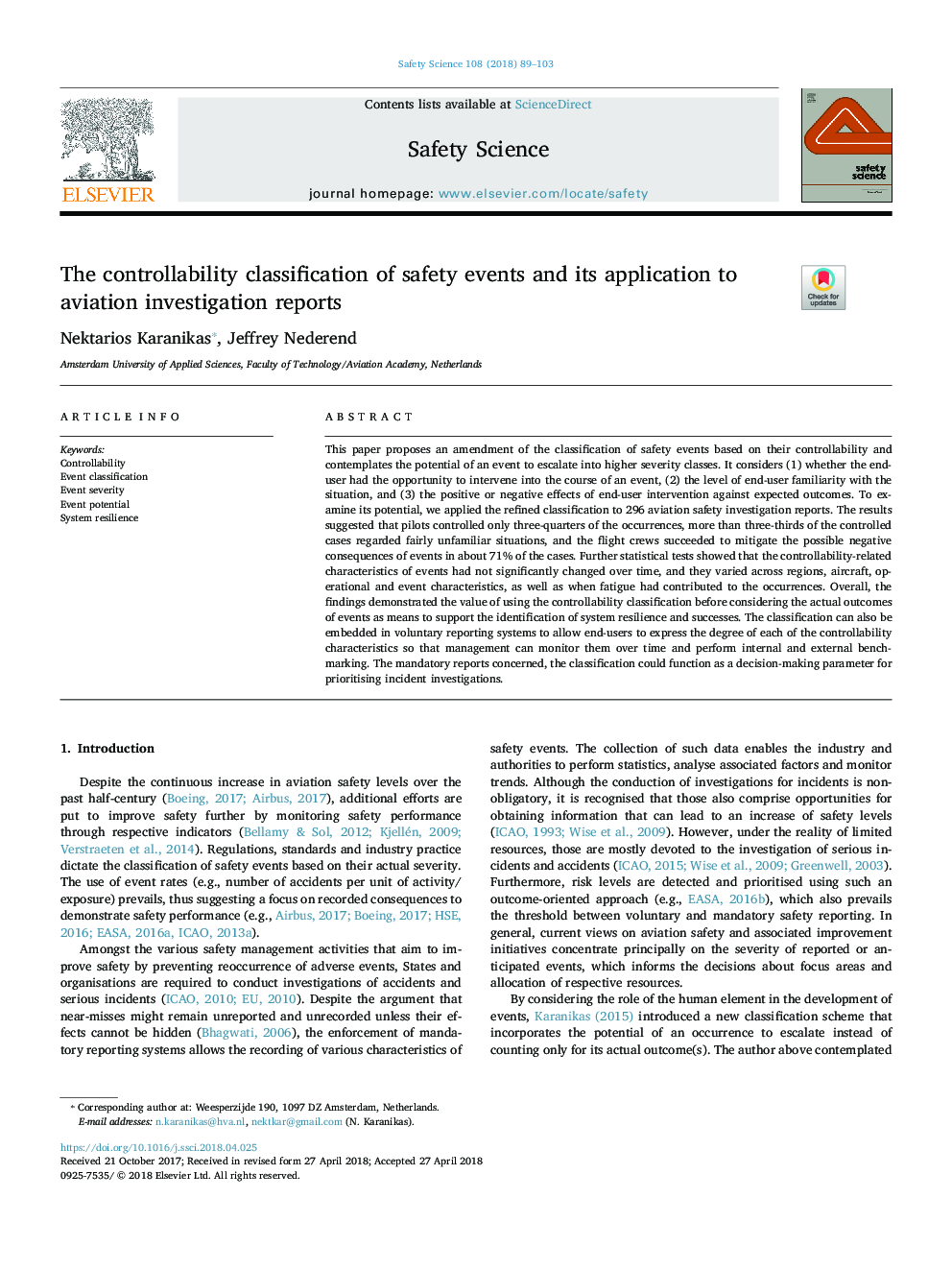| کد مقاله | کد نشریه | سال انتشار | مقاله انگلیسی | نسخه تمام متن |
|---|---|---|---|---|
| 6974773 | 1453364 | 2018 | 15 صفحه PDF | دانلود رایگان |
عنوان انگلیسی مقاله ISI
The controllability classification of safety events and its application to aviation investigation reports
ترجمه فارسی عنوان
طبقه بندی کنترل پذیری رویدادهای ایمنی و کاربرد آن در گزارش های تحقیقاتی مربوط به حمل و نقل هوایی
دانلود مقاله + سفارش ترجمه
دانلود مقاله ISI انگلیسی
رایگان برای ایرانیان
کلمات کلیدی
کنترل طبقه بندی رویداد، شدت رویداد، پتانسیل رویداد، انعطاف پذیری سیستم،
ترجمه چکیده
این مقاله اصلاح طبقه بندی رویدادهای ایمنی را بر اساس کنترل پذیری خود ارائه می دهد و احتمال وقوع یک رویداد را در کلاس های شدت بالاتری گسترش می دهد. به نظر می رسد (1) اینکه آیا کاربر نهایی فرصتی برای مداخله در جریان یک رویداد داشت، (2) سطح آشنایی نهایی کاربر با وضعیت و (3) اثرات مثبت یا منفی مداخلات کاربر نهایی در مقابل نتایج مورد انتظار برای بررسی پتانسیل آن، طبقه بندی تصفیه شده را به 296 گزارش تحقیقات ایمنی حمل و نقل اعمال کردیم. نتایج نشان می دهد که خلبانان تنها سه چهارم وقایع را کنترل می کنند، بیش از سه سوم موارد کنترل شده، موقعیت های ناآشنا را در نظر گرفته اند و خدمه پرواز موفق به کاهش عواقب منفی حوادث در حدود 71٪ موارد شده است. تست های آماری بیشتر نشان داد که ویژگی های مرتبط با کنترل پذیری حوادث در طول زمان تغییری نکرده و در مناطق مختلف، هواپیما، ویژگی های عملیاتی و رویدادی، و همچنین زمانی که خستگی به رخدادها کمک کرده است، متفاوت بود. به طور کلی یافته ها نشان می دهد که ارزش استفاده از طبقه بندی کنترل پذیری قبل از بررسی نتایج واقعی رویدادها به عنوان وسیله ای برای حمایت از شناسایی قابلیت انعطاف پذیری و موفقیت سیستم است. طبقه بندی همچنین می تواند در سیستم های گزارش داوطلبانه تعبیه شود تا کاربران نهایی بتوانند درجه هر یک از ویژگی های کنترل را بیان کنند تا مدیریت بتواند در طول زمان آنها را نظارت کند و معیارهای داخلی و خارجی را ارزیابی کند. گزارش های اجباری مربوط به آن، طبقه بندی می تواند به عنوان یک پارامتر تصمیم گیری برای اولویت دادن به تحقیقات حادثه عمل کند.
موضوعات مرتبط
مهندسی و علوم پایه
مهندسی شیمی
بهداشت و امنیت شیمی
چکیده انگلیسی
This paper proposes an amendment of the classification of safety events based on their controllability and contemplates the potential of an event to escalate into higher severity classes. It considers (1) whether the end-user had the opportunity to intervene into the course of an event, (2) the level of end-user familiarity with the situation, and (3) the positive or negative effects of end-user intervention against expected outcomes. To examine its potential, we applied the refined classification to 296 aviation safety investigation reports. The results suggested that pilots controlled only three-quarters of the occurrences, more than three-thirds of the controlled cases regarded fairly unfamiliar situations, and the flight crews succeeded to mitigate the possible negative consequences of events in about 71% of the cases. Further statistical tests showed that the controllability-related characteristics of events had not significantly changed over time, and they varied across regions, aircraft, operational and event characteristics, as well as when fatigue had contributed to the occurrences. Overall, the findings demonstrated the value of using the controllability classification before considering the actual outcomes of events as means to support the identification of system resilience and successes. The classification can also be embedded in voluntary reporting systems to allow end-users to express the degree of each of the controllability characteristics so that management can monitor them over time and perform internal and external benchmarking. The mandatory reports concerned, the classification could function as a decision-making parameter for prioritising incident investigations.
ناشر
Database: Elsevier - ScienceDirect (ساینس دایرکت)
Journal: Safety Science - Volume 108, October 2018, Pages 89-103
Journal: Safety Science - Volume 108, October 2018, Pages 89-103
نویسندگان
Nektarios Karanikas, Jeffrey Nederend,
